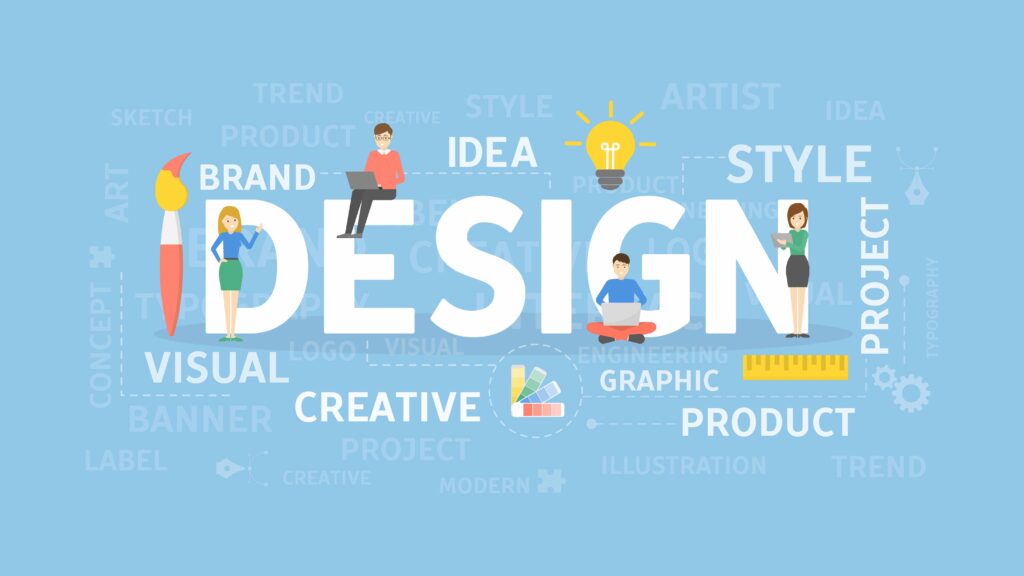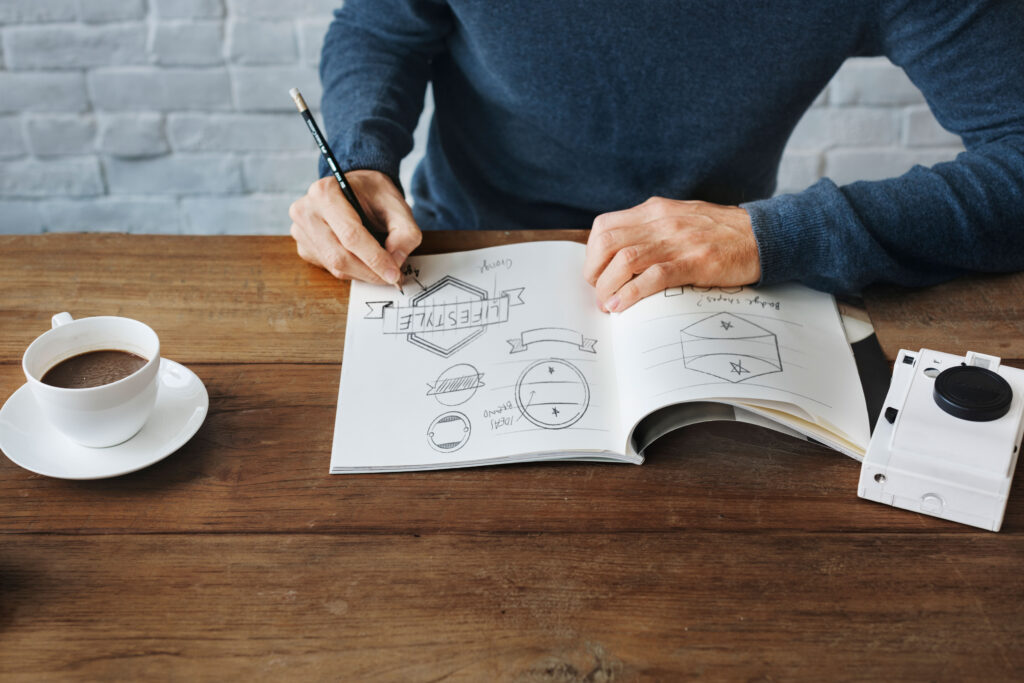Graphic design plays a crucial role in today’s visual world, helping businesses and individuals communicate their messages effectively. Whether it’s creating stunning logos, captivating advertisements, or compelling website layouts, graphic design encompasses a wide range of visual communication techniques. In this article, we will delve into the fascinating process of graphic design, from concept to creation, shedding light on the various stages involved and the elements that contribute to exceptional designs.
Introduction:
Graphic design is more than just aesthetics; it is a strategic blend of artistry, problem-solving, and effective communication. By combining typography, imagery, colors, and layout, graphic designers bring concepts to life, capturing attention and conveying messages in a visually compelling manner.

Understanding the Concept of Graphic Design
Before we dive into the process, let’s establish a solid foundation by understanding the core elements and principles that underpin graphic design. The elements include line, shape, color, texture, space, and form, while the principles encompass balance, proximity, contrast, repetition, alignment, and hierarchy. Familiarizing ourselves with these fundamentals helps us make informed decisions during the design process.
Research and Ideation
Every successful graphic design project begins with comprehensive research and ideation. Designers start by gathering client requirements, understanding their target audience, and studying the market landscape. By identifying competitors and analyzing industry trends, designers can ensure that their designs stand out and effectively communicate the desired message.

Once the research phase is complete, designers move on to the ideation process. This involves brainstorming and sketching out various concepts and ideas. The goal is to explore different visual approaches that align with the client’s goals and resonate with the target audience. Through this creative exploration, designers can identify the most promising directions to pursue.
Creating a Mood Board
With the ideas taking shape, it’s time to create a mood board. A mood board is a visual compilation of inspirations, color schemes, typography styles, and imagery that set the tone and direction for the design. By curating a collection of visuals, designers can establish a cohesive visual language and ensure that their design choices are aligned with the desired aesthetic and brand identity.
Developing the Initial Design
Armed with a solid understanding of the client’s requirements and armed with the inspiration from the mood board, designers begin developing the initial design. This involves translating the ideas and concepts into digital formats using design software and tools. Designers experiment with layouts, typography, and imagery to create a rough representation of the final design.
Refining and Iterating the Design
Design is an iterative process, and feedback plays a crucial role in refining and improving the initial design. Designers seek input from clients and other stakeholders, incorporating their suggestions and making necessary revisions. The goal is to strike a balance between aesthetics and functionality, ensuring that the design not only looks visually appealing but also serves its intended purpose effectively.
During this stage, attention to detail is paramount. Designers pay close attention to typography choices, ensuring legibility and readability. They refine the placement of elements, optimizing the visual hierarchy to guide the viewer’s attention. By refining the design iteratively, designers can enhance its overall impact and create a seamless user experience.
Typography and Visual Hierarchy
Typography is a crucial aspect of graphic design, as it plays a significant role in conveying the intended message. Designers carefully select fonts that align with the brand’s personality and evoke the desired emotions. They establish a visual hierarchy by using varying font sizes, weights, such as spacing, alignment, and proportion to create a cohesive and well-structured design.

Implementing grids and guidelines helps designers maintain consistency and alignment throughout the design. By following established design principles and guidelines, they ensure that the layout is easy to navigate and visually appealing. A thoughtful composition enhances the overall user experience and ensures that the design effectively delivers its message.
Finalizing the Design
Once the design has gone through several iterations and refinements based on feedback, it’s time to finalize it. Designers review the design meticulously, checking for any errors, inconsistencies, or typos. They pay attention to every detail, ensuring that the design elements are aligned, colors are consistent, and typography is accurate.
In addition, designers prepare the design files for various formats and platforms. They consider different file types, resolutions, and color profiles to ensure that the design can be seamlessly reproduced across different mediums, such as print or digital platforms.
Collaboration and Client Feedback
Throughout the graphic design process, collaboration and effective communication with clients play a crucial role. Designers regularly seek feedback from clients and incorporate their input into the design. This collaborative approach ensures that the design aligns with the client’s vision and meets their expectations.
Managing revisions and iterations is a key aspect of collaboration. Designers work closely with clients to understand their preferences and make the necessary adjustments. By maintaining open lines of communication, designers foster a productive working relationship that leads to successful design outcomes.
The Role of Technology in Graphic Design
Technology has revolutionized the field of graphic design, providing designers with powerful tools and software to create stunning visuals. Designers utilize design software such as Adobe Creative Suite, Sketch, or Canva to bring their ideas to life. These tools offer a wide range of features and functionalities that streamline the design process and enhance productivity.
While technology has brought about significant advancements, it’s important to strike a balance between traditional and modern techniques. Designers still rely on fundamental design principles, creativity, and artistic skills to craft exceptional designs. The integration of technology and traditional design practices enables designers to push the boundaries of creativity and deliver innovative solutions.
Graphic Design Trends and Innovations
The field of graphic design is ever-evolving, with new trends and innovations constantly emerging. Designers stay up to date with the latest industry trends, exploring new design styles, techniques, and visual aesthetics. By embracing these trends and incorporating them into their work, designers can create designs that feel fresh, relevant, and visually appealing.
However, it’s important to approach trends with a discerning eye. Designers must evaluate whether a trend aligns with the client’s goals and the intended message of the design. By striking a balance between embracing trends and maintaining design integrity, designers can create designs that stand the test of time.
Conclusion
From concept to creation, the process of graphic design is a fascinating journey that requires creativity, research, collaboration, and attention to detail. Graphic designers employ a strategic blend of elements, principles, and techniques to transform ideas into visually captivating designs that effectively communicate messages.
Graphic design has a profound impact on various industries, from branding and marketing to user experience and visual storytelling. By embracing the design process and staying open to innovation, designers have the power to shape perceptions, evoke emotions, and create memorable experiences through their designs.
As you embark on your own graphic design projects, remember to explore, experiment, and embrace your creativity. The possibilities are endless, and with each design, you have the opportunity to unveil something unique and impactful to the world.
We, at Zenax Studio, are Graphic Design enthusiasts who are helping enterprises worldwide. Have a query or want to discuss Graphic Design projects? Schedule a meeting with us here, we’ll be happy to talk to you.
